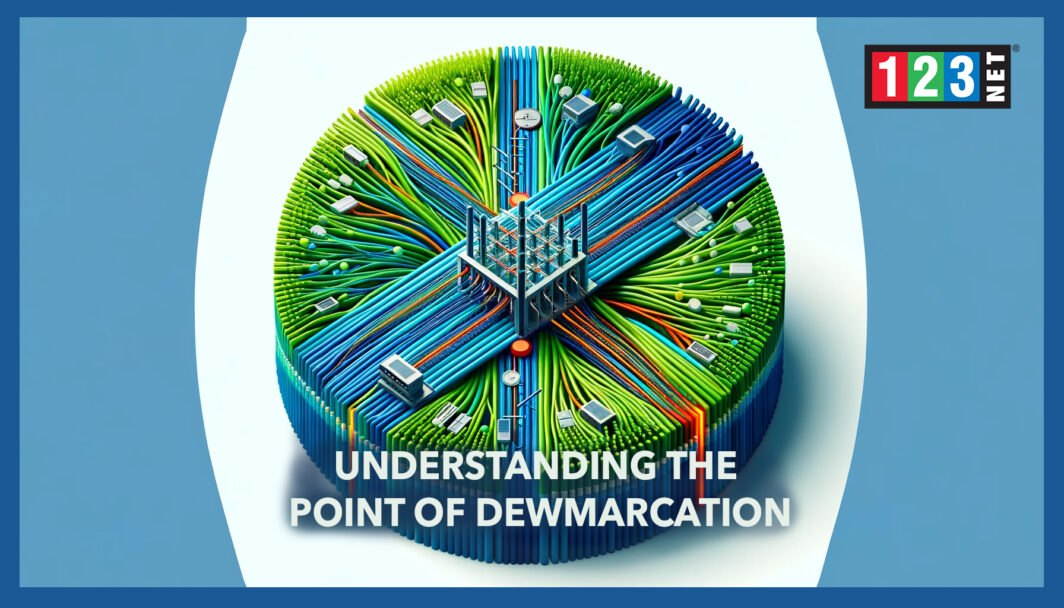
Introduction
The point of demarcation (demarc) stands as a pivotal concept within the realm of telecommunications, signifying the juncture where the public switched telephone network (PSTN) concludes and an establishment’s internal network commences. This boundary transcends mere physical separation, embodying a clear division of responsibility between telecom service providers and their clientele. Grasping the essence of the demarcation point proves crucial for those engaged in the oversight, design, or upkeep of telecom infrastructures, as it demystifies the accountability for various segments of the network. This exposition aims to shed light on the importance, historical evolution, varieties, and advantages of demarcation points, while also navigating through the standards and exemplary practices within this domain.
The Role of the Demarcation Point in Telecommunications
The demarcation point, often referred to as the demarc, holds a crucial position in the telecommunications landscape. It marks the network boundary, distinguishing the external service provider’s infrastructure from a building or facility’s internal network. This distinct boundary is vital, as it clarifies the division of responsibility between telecom providers and their customers for maintenance, repair, and system upgrades. Service providers are accountable up to the demarc point; responsibilities for the internal network, tackling connectivity issues, and executing maintenance or upgrades fall to the customer beyond this point.
The implementation of structured cabling systems from the demarcation point across a facility is essential for the efficient and effective transmission of voice, data, and video communications. These systems are meticulously engineered to accommodate a broad spectrum of telecommunications services, ranging from basic telephone connectivity to advanced high-speed internet access. By doing so, they form the backbone of a building’s telecom infrastructure, ensuring robust and reliable communication channels.
Moreover, the demarcation point’s role extends beyond mere physical separation. It embodies a critical aspect of telecom regulation, aligning with telecommunications standards that dictate service provider responsibility and network interface specifications. The inclusion of circuit protection mechanisms within the demarcation point safeguards the internal network from potential electrical surges and interference, further emphasizing its significance in maintaining the integrity and security of telecom infrastructures. Through this, the demarcation point not only facilitates clear operational boundaries but also enhances the overall resilience and performance of telecommunications systems within a facility.
Historical Background of Demarcation Points
The demarcation point’s significance has seen considerable evolution since the early 20th century. Initially, telecommunications entities controlled every aspect of the network, including the wiring inside customer premises. The landscape of regulation underwent a profound transformation with the antitrust division of AT&T in 1984. This pivotal event heralded the demarcation point as a mandated legal standard, empowering customers to select their equipment. The service providers past the network interface offered by the emergent “Baby Bells.”
This historical transition highlighted the critical need to delineate network boundaries. It aimed not just at clarifying the responsibilities of service providers but also at stimulating competition and innovation within the telecommunications sector. The establishment of the demarcation point as a distinct boundary has since played a foundational role. This is ensuring a clear division of ownership and maintenance duties between service providers and customers. This clarity has, in turn, contributed to the growth and diversification of telecommunications services, reflecting the demarcation point’s enduring impact on the industry.
Types of Demarcation Points
The landscape of telecommunications infrastructure is dotted with various types of demarcation points, each tailored to meet distinct connectivity needs:
- Network Interface Device (NID): This is the foundational form of demarcation, often found as a weatherproof enclosure on a building’s exterior. It houses critical components such as wiring termination blocks and circuit protection mechanisms, which defend against electrical surges, ensuring the safety and integrity of internal networks.
- Smartjack/Intelligent Network Interface Device (INID): These devices represent a step up in functionality, catering to the demands of higher-bandwidth connections. Equipped with advanced circuitry, they support intricate telecommunications services, including T1 lines. A notable feature is their capability for remote diagnostics. This is allowing service providers to troubleshoot issues without needing physical access to the equipment.
- Optical Network Terminal (ONT): The advent of fiber optic technology has necessitated the development of ONTs, devices pivotal for bridging optical signals with a building’s electrical wiring. They play a key role in facilitating high-speed broadband services through fiber networks. Also they are converting optical signals into electrical ones that are compatible with existing internal infrastructure.
Each demarcation point variant is engineered with specific telecommunications scenarios in mind, from providing basic voice services to enabling sophisticated digital communications. This ensures seamless compatibility and connectivity within the broader telecom infrastructure. This is highlighting the critical role demarcation points play in modern telecommunications. By catering to a wide range of service requirements, these devices underscore the evolving nature of telecom networks. As well as the continuous need for adaptable and resilient infrastructure solutions.

Benefits of Implementing a Demarcation Point
Demarcation points bring forth a multitude of advantages, pivotal for maintaining the integrity and operational efficiency of telecommunications networks:
- Component Protection: Demarcation points are equipped with circuit protection mechanisms that play a crucial role. By in shielding the internal networks from external electrical surges. This protective measure is essential for preserving the longevity and reliability of the telecom infrastructure. It is ensuring that the core components remain unaffected by potentially damaging voltage spikes.
- Simplified Troubleshooting: Demarcs significantly ease the process of identifying connectivity issues. This delineation allows businesses to swiftly ascertain whether a problem stems from within their own network. This is facilitating quicker resolutions and minimizing downtime.
- Enhanced Service Flexibility: The establishment of a demarcation point empowers businesses with the ability to connect telecommunications equipment. This openness encourages a competitive market landscape, ultimately benefiting consumers with improved services and more competitive pricing structures.
- Network Security: Advanced demarcation devices are capable of offering additional layers of security. Also, safeguarding sensitive business communications against potential external threats. These enhanced security features are instrumental in protecting the integrity of business data and communications. This is providing an added level of defense in today’s increasingly digital and interconnected world.
Together, these benefits underscore the critical role that demarcation points play in the architecture of modern telecommunications networks. By ensuring component protection, simplifying troubleshooting, enhancing service flexibility, and bolstering network security, demarcs contribute significantly to the robustness and resilience of telecom infrastructures.

Demarcation Point Extensions: What You Need to Know
A demarcation point extension becomes essential when there’s a significant distance between the service provider’s demarcation point and a business’s telecom closet or equipment room. This process entails the installation of additional cabling from the demarc to the business’s internal network. The primary goal is to ensure that telecommunications services are smoothly integrated into the building’s existing infrastructure, facilitating uninterrupted connectivity. The complexity of these extensions can vary, ranging from straightforward cable runs to more intricate installations that may require sophisticated routing and connectivity solutions.
Typically, these tasks are undertaken by skilled technicians who possess the necessary expertise to execute the extensions efficiently and effectively. Their work ensures that the extended network meets the specific communication requirements of the business. Whether for expanding voice, data, or video communication capabilities, a demarcation point extension is a critical step in enhancing a business’s telecom infrastructure.
Standardization and Best Practices
Despite their pivotal role in telecommunications, demarcation points suffer from a notable absence of uniform standards. This lack of standardized guidelines can result in less-than-ideal cabling practices. Such inconsistencies might hinder the optimal performance of telecom infrastructures and complicate maintenance and upgrades. However, adherence to established industry best practices for the design and installation of these systems can significantly alleviate these challenges. By following these guidelines, businesses can ensure the reliability and efficiency of their network operations.
Engaging with seasoned structured cabling contractors is highly recommended to effectively navigate these complexities. These professionals bring a wealth of experience and expertise, making them invaluable partners in establishing or upgrading a telecom infrastructure. Their knowledge of best practices mean that they can help overcome the hurdles posed by the lack of uniform standards. Collaboration with such contractors ensures that a business’s telecom infrastructure is capable of supporting its communication needs.
Conclusion
The demarcation point stands as a cornerstone in modern telecommunications, marking the essential boundary between public and private networks. Ensuring its correct implementation and ongoing maintenance is crucial for maintaining the reliability, security, and operational efficiency of telecom services. As the field of telecommunications progresses, the importance of comprehensively understanding and following the guidelines related to demarcation points persists. For both businesses and service providers, staying informed and compliant with these principles is key to navigating the complexities of today’s telecom environment effectively.




